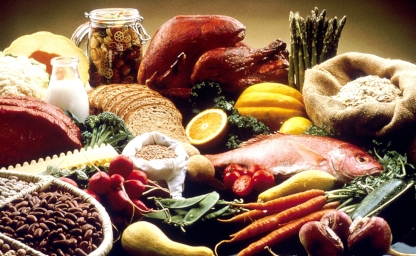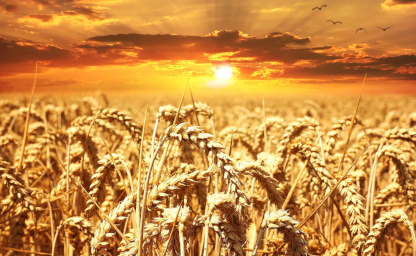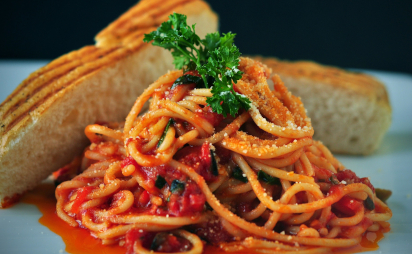
Definition
The process by which the body breaks down food physically by teeth and chemically by enzymes and convert it into parts suitable for absorption in the alimentary canal.
The Mouth
As soon as we place food in our mouth the digestive
system starts to work by biting and chewing. Only one digestive
enzyme, amylase (for starch), is present in the mouth. However,
food is normally not in the mouth long enough to permit complete
digestion and little nutrient absorption takes place in the
mouth.
The Stomach
The primary function of the stomach is to break large proteins into smaller blocks of proteins called peptides and peptones. Pepsin is an enzyme produced in the acidic environment of the stomach (1.5 to 7.0 pH) which digests proteins into smaller peptides of varying lengths. Other enzymes such as gelatinase (for gelatin) digest specific proteins.
Amylase (the enzyme that breaks down starch) is inactivated, or destroyed, when stomach pH falls below 6.5. Before this happens however, up to 50% of starches may be partially broken down. Some fat is emulsified (broken up into smaller pieces) in the stomach by bile acids, and the enzyme lipase, to aid digestion in the small intestine. At the average stomach pH of 2.0, however, most fat is formed into large globules that pass unchanged into the small intestine. Small amounts of sucrose (table sugar) may be broken apart into glucose and fructose by acid hydrolysis from the bile acids in the stomach.
The Intestines
Virtually all absorption of nutrients (macronutrients such as carbohydrates and fats and micronutrients such as vitamins and minerals) occurs in the intestines. Absorption of nutrients is, in fact, the primary function of the small intestine. Most carbohydrates, for instance, are absorbed in the small intestine. The pancreatic enzymes secreted into the small intestine also contain amylase which breaks down starches into a disaccharide (two sugars joined together) called maltose. In the intestines, enzymes such as maltase and lactase break disaccharides into single sugars (monosaccharides), such as glucose. When adults and older children do not have enough lactase to digest lactose (the sugar in milk) lactose intolerance results and milk cannot be completely digested.
When food leaves the stomach, digestion is completed in the small intestine with the help of the enzymes secreted by the pancreas (lipase, amylase, protease, maltase, trypsin and chymotrypsin). The pH of food mass increases from about 2.0 to 6.5 (still slightly acidic), as it passes from the stomach through the small intestine to the colon. Very few nutrients, except water, is absorbed by the large intestine (colon).
Enzymes
An enzyme is a protein that acts as a catalyst in a biological reaction. It binds itself to a substance and converts it into another substance. Enzymes are very specific in their functions, which is why there are different enzymes for different biological reactions. In the case of digestion, distinct forms of food require specific enzymes. Unless proteins, fats and carbohydrates (sugars) are reduced to smaller absorbable components they will remain in the digestive track. The following list gives a glance for what each enzyme breaks and where it is produced:
- Amylase - starches into maltose (a disaccharide):
saliva and pancreas - released into the small intestine
- Lipase - fats (lipids): in stomach and pancreas
- released into the small intestine
- Pepsin - proteins into absorbable peptides and
peptones: stomach
- Gelatinase - gelatin: stomach
- Maltase - maltose into monosaccharides: produced by
the pancreas - released into the small intestine
- Lactase - lactose into monosaccharides: small intestine
- Trypson - proteins into peptides and amino acids: pancreas
- released into small intestine
- Chymotrypson - proteins into peptides and amino acids: pancreases
- released into small intestine
The following chart explains where action and what action takes place in a fully functional digestive system:
| Organs |
Enzymes |
Action |
| mouth |
Amylase in saliva |
mechanical digestion of all food (teeth chewing
& grinding) chemical digestion of carbohydrates begins with amylase |
| oesophagus |
none |
food passes from mouth through the oesophagus to
the stomach |
| stomach |
pepsin
gastric juice
hydrochloric acid
lipase, gelatinase |
mechanical digestion of food (churning of stomach
walls) and chemical digestion of proteins begins with pepsin while
lipase breaks some of the fats and gelatinase breaks down gelatins |
| small intestine |
pancreatic juice
intestinal juice
bile, lipase, maltase, lactase
|
chemical digestion of carbohydrates, proteins, &
lipids continues & is completed
the small, soluble nutrients (sugars, amino acids, fatty acids)
are absorbed |
| large intestine |
none |
water is absorbed from unusable, indigestible wastes
(faeces) |
Persons who suffer from food intolerance may suffer from weight
loss and malnutrition if kept ignored.
There are several causes why one does not produce enough enzymes or
nothing at all. Most lactose intolerant persons do not produce enough
lactase, hence by supplementing their diet with commercially available
lactase enzyme they avoid suffering the symptoms (see Lactose Intolerance). On the other hand persons
who had their pancreas removed may suffer symptoms because they may not
be able to produce enough enzymes such as amylase, lipase and maltase
amongst others.

Food & Lactose Intolerance
Food intolerance is the inability to
completely break down food resulting in cramps, bloating,
wind, diarrhoea etc.
Lactose Intolerance
(milk) is the most common form and affects half the world
population. Food Allergy is not Lactose Intolerance. A guide
is provided.

Food & Milk Allergy
Food allergy is caused when the immune
system mistakenly responds to food proteins thinking they
are harmful substances. Symptoms include vomiting, itching,
rash, and hives. Allergies in children are very common,
but treatment with digestive enzymes may prove very helpful.

Coeliac or simply Wheat Sensitive?
In Coeliac Disease, gluten causes damage
to the small intestines, however, more people are wheat
sensitive. This shows negative in blood tests. Read how
to diagnose and avoid false negative screening results.

Baby Colic
Baby colic is very distressing to both the baby and the
parents. However, studies conclude that half the babies
suffer due to lactase deficiency. This is easily treated
by neutralising milk with lactase enzyme.

IBS or Simply Food Intolerance?
Medical studies confirmed 50% of patients diagnosed with
Irritable Bowel Syndrome may in fact be Lactose Intolerant.
Omitting dairy products from their diet, or treating it
with enzymes has helped them start a new life. Since IBS
symptoms are similar to LI, diagnosis can be confusing.

Carbohydrate Intolerance and Obesity
The inability to break down starch and other sugars leads
to bloating, wind, cramps, diarrhoea, etc. Now there is
evidence that obesity may be related to carbohydrate intolerance.
There is some good news with the help of digestive enzymes

Food Additives & E Numbers
The Romans used them, they come in 'numbers' or in weird
names. Some are healthy but others are 'bad' despite being
approved for consumption and depending where you live. Watch
out for the ones to avoid and the others not to worry about

Fructose Intolerance vs. Malabsorption
Fructose Intolerance is a rare genetical disorder and
leads to severe symptoms and may prove dangerous.
Fructose Malabsorption has symptoms similar to Lactose
Intolerance and avoidance of fruits helps.

Alcohol Allergy & Intolerance
Once ingested, alcohol is quickly broken down by enzymes
produced in the liver. Otherwise it is a toxin and the body
will react. Many people of oriental origin lack this enzyme
and this explains why they turn red when drinking alcohol.
So what is the cure?









